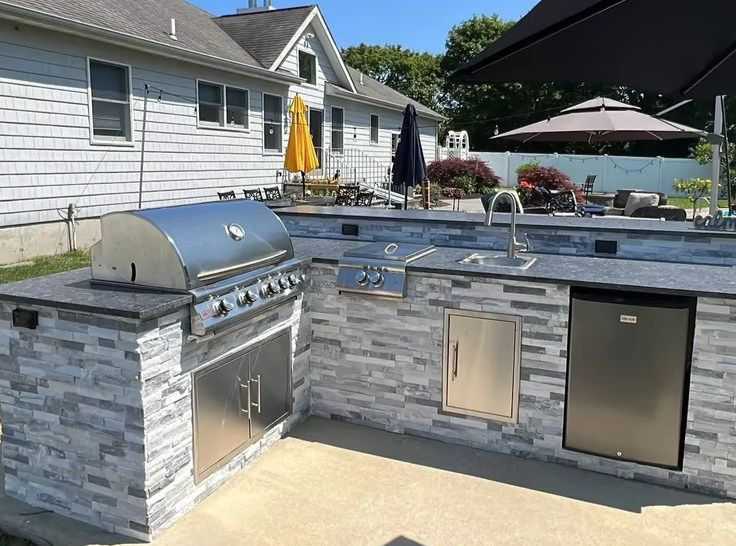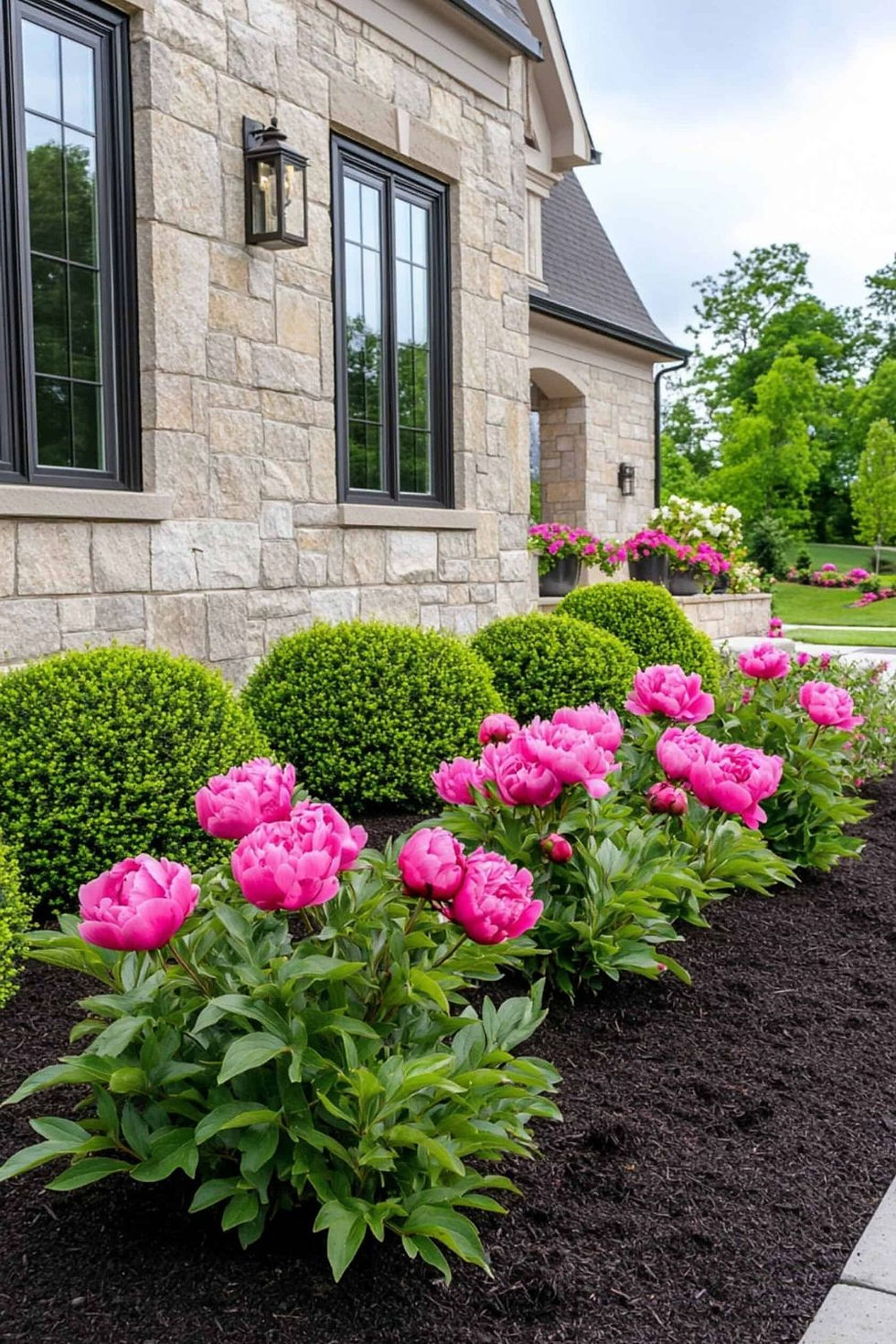Ultimate Outdoor Entertainment: Designing Kitchens for Summer BBQs, Choosing Lighting, Building Pizza Ovens, and Cozy Fire Pit Ideas
- nickharasym
- Jul 7
- 6 min read
Updated: Jul 11
Summer is just around the corner, and it's the perfect time to fire up the grill and enjoy the outdoors with friends and family. You can take outdoor entertainment to the next level by dining outside, lounging by a cozy fire pit, or connecting with loved ones under magical twinkling lights. A beautiful outdoor space can transform your backyard into a sanctuary, whether you want to enjoy a quiet coffee in the morning or host the next lively summer BBQ.
From wood-burning pizza ovens to grills, lighting, and fireplace designs, the options to create your perfect outdoor space are limitless. However, so many options can be overwhelming, and you might not know where to start. In this ultimate guide to outdoor entertainment, we've compiled some tips to help you design your dream backyard.
Keep reading for inspiration!

Designing an Outdoor Kitchen
Take summer BBQs to the next level by cooking and dining in your own backyard! Outdoor kitchens provide the perfect setting to entertain guests, allowing you to connect with friends and family while enjoying great food outside. Here are a few things to consider when designing your outdoor kitchen:
1. Space and Layout
The size of your yard will affect your layout options and overall design. Measure and assess the available space in your backyard, where your outdoor kitchen will be located. Factor in adequate pathways, walking space, storage options, space for seating and dining areas, and possible layouts.
For a small outdoor kitchen, consider a compact grill with a small side sink or built-in refrigerator. A galley-style layout or an L-shaped kitchen can maximize functionality in a small space. Consider built-in seating or utilizing vertical space with wall-mounted shelves or cabinets for storage to get the most out of a small backyard kitchen.
For a large outdoor space, consider a full-fledged outdoor kitchen with features like a grilling station, pizza oven, or bar. A central island can serve as a gathering spot or provide extra counter space for food prep and cooking. L-shaped or U-shaped layouts offer ample counter space and can accommodate multiple appliances or storage options. Consider adding a pergola or pavilion to provide shade for your guests.
2. Appliances
Appliances define the functionality of your outdoor kitchen. When choosing appliances, consider your usual specific cooking habits and preferences. Start with the essentials and expand from there as your space and budget allow. Some possible appliances include:
Grill - The BBQ grill is the heart of every outdoor kitchen! Built-in gas grills offer convenience and quick heating, while charcoal grills provide a smoky flavor.
Pizza Oven - A pizza oven is a great addition to any outdoor kitchen, offering a unique cooking experience. Outdoor pizza ovens can be wood-fired, gas-powered, or electric, each offering unique benefits and cooking styles. Wood-fired ovens deliver authentic flavor, while gas and electric options offer convenience and faster cooking times. Creating your own pizzas makes mealtime fun and engaging for kids and adults alike! However, pizza ovens are not just limited to cooking pizza and can be used for a variety of baked goods.
Refrigerator - Keeps foods and beverages cool and accessible.
Sink - A sink allows for easy hand washing, food preparation, and clean up.
Storage - Cabinets and storage space keep your outdoor kitchen organized and functional.
Other appliance options might include an ice maker, side burner, flat-top griddle, or smoker.
3. Budget
The cost of an outdoor kitchen can vary widely. Before you begin, determine a realistic budget and stick to it. Factor in costs like materials, appliances, labor, permits, and utilities. Prioritize your essential elements and expand your kitchen as your budget allows.
Lighting Options
Outdoor lighting allows you to use your outdoor space even after dark, extending entertaining hours after the sun goes down. The right lighting can create a cozy, relaxing ambience and can be used to highlight certain features or activities in your yard. Lastly, proper lighting is essential for safety and security, improving visibility and preventing injury after dark, while also deterring potential intruders and enhancing home security.
Some popular lighting options include:
String Lights - String lights can be strung in various arrangements, adding a magical atmosphere to any outdoor space.
Lanterns - Lanterns provide soft, warm lighting and can be placed on tables, steps, or hung from structures or tree branches.
Wall Sconce - A wall sconce is a decorative light fixture mounted on an exterior wall. They come in various styles and finishes and are typically used to illuminate a porch, patio, or walkway.
Floodlights - Floodlights are used to illuminate large areas with a broad, intense beam of light, enhancing visibility and safety. They might be used to light driveways or parking areas.
Step Lights - Step lights, or stair lights, are small, low-profile light fixtures installed on the sides or under the treads of outdoor steps to illuminate the way. They primarily serve as a safety measure, reducing the risk of trips and falls in the dark. They can also add to a property's curb appeal and create a more inviting atmosphere.
Post Lights - Post lights are designed to be mounted onto a pole or post, adding a touch of elegance and providing illumination for driveways, entryways, pathways, patios, or gardens.
Pendant Lights - Outdoor pendant lights, or hanging lights, are fixtures that hang from a ceiling or structure to provide focused, overhead lighting outdoors. They can be used to illuminate covered porches, patios, entryways, gazebos, or outdoor dining tables. Pendant lights are perfect for adding a touch of elegance and charm to an outdoor space.
Solar Lights - Solar lights offer an energy-efficient way to illuminate your outdoor space and are available in a variety of options. Some popular choices include solar string lights, pathway lights, or post caps.

Fire Pits
A cozy fire pit creates a warm, intimate atmosphere that allows you and your guests to enjoy the outdoors after dark and even into the cooler months. Fire pits are the perfect addition to any backyard. They serve as a central gathering space, providing heat and light, and allowing you to connect and socialize with family and friends, or simply relax and unwind by the comfort of the fire.
There are a few factors to consider when choosing an outdoor fire pit.
1. Fuel Type
Wood - Classic wood fire pits are best for those who love a traditional, rustic campfire experience. Wood is generally more affordable than other fuel sources and provides intense heat, but requires more effort. Smoke and sparks might be an issue.
Propane - Propane fire pits are convenient and easy to use, producing little to no smoke or ash. They ignite instantly at the push of a button! However, you will need to regularly refill or exchange your propane tanks, which can be cumbersome and costly, especially if you use your fire pit often. Propane tanks need to be stored safely.
Natural Gas - Natural gas fire pits offer a convenient, clean option for an outdoor fire pit. They are easy to use, lighting with the flip of a switch and providing a constant fuel supply. While the installation may be expensive, natural gas is often cheaper than propane in the long run and may add to the value of your home.
2. Size and Shape
Fire pits come in a variety of shapes and sizes, including round, square, and rectangular. Consider the size of your outdoor space and the number of people who will be using the fire pit. Round fire pits offer a classic, communal feel, suitable for large gatherings and even heat distribution. Square or rectangular fire pits provide a more modern look and structural layout, potentially allowing for additional features like built-in storage or wind guards. Consider the height and circumference of the fire pit to ensure it fits within your space.
3. Material
Choose a fire pit design that complements your outdoor decor and personal style. Some material options include:
Stone or Brick - Stone or brick fire pits are durable and aesthetically pleasing, but heavier and less portable.
Stainless Steel - Steel fire pits are rust-resistant and low maintenance. They are available in a variety of shapes and styles, from sleek and modern to more rustic designs. Prolonged exposure to heat can cause stainless steel to change color, particularly on the inside of the fire pit.
Cast Iron - Cast iron fire pits are known for their durability, heat retention, and aesthetic appeal. They can withstand high temperatures and harsh weather, making them a long-lasting option for outdoor use. Regular cleaning and maintenance, including rust prevention, are necessary to keep a cast iron fire pit looking its best and prolong its life.
4. Safety
Safety is always paramount when installing a fire pit in your outdoor space. Choose a level, open area away from trees, shrubs, and low-hanging branches, and ensure a safe distance from your home or other structures. Ensure proper airflow and ventilation to prevent dangerous gas buildup, and make sure you have easy access to emergency equipment if necessary.
Ready to transform your outdoor space into the backyard of your dreams? Neil and Nick's Landscaping can help make it happen! Contact us today to get your project started.




Comments